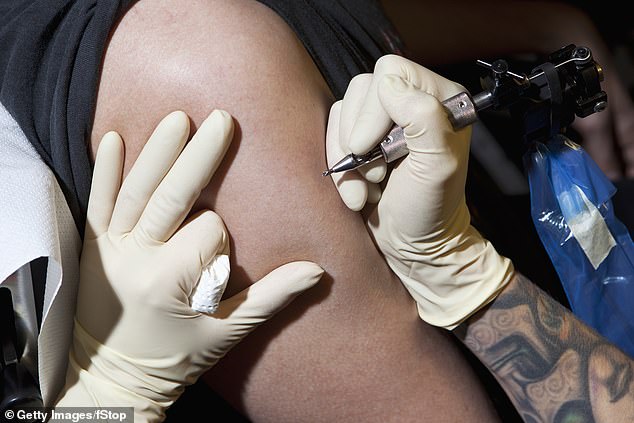More than a quarter of Brits have a tattoo, whether for decorative or cosmetic purposes such as permanent makeup; or for medical purposes, such as nipple tattoos after mastectomies.
Now a new study suggests that having a tattoo may increase the risk of a type of blood cancer called lymphoma which affects around 14,000 people a year in the UK.
But should people worry?
In the new study, researchers at Lund University in Sweden found that those with tattoos had a 21 percent increased risk of lymphoma compared to those without.
The theory is that tattoos trigger low-grade inflammation, a known precursor to cancer, but this is the first study to establish a connection with tattoos.
A new study suggests that having a tattoo may increase the risk of a type of blood cancer called lymphoma which affects around 14,000 people a year in the UK.

Dr. Christel Nielsen, associate professor of epidemiology, says tattoo ink can contain substances linked to cancer (i.e. carcinogens), such as heavy metals.
An earlier study in 2020 found no such link, while research in The Lancet in 2011 ruled that an apparent link to skin cancer was nothing more than a coincidence.
For the latest study, the Lund University team looked at all people in Sweden who had been diagnosed with lymphoma between the ages of 20 and 60 between 2007 and 2017 (a total of 1,398 people) and compared the results with people who They had not had cancer. .
They all completed questionnaires about their lifestyles and whether they had any tattoos and, if so, how big the tattoo was, when they got it, and whether they had any removed.
The results, published in the journal eClinicalMedicine, found that the risk of lymphoma was highest in the first two years after getting a tattoo and then decreased, but increased again 11 years later. The researchers expected that larger tattoos would increase the risk, but it turned out that this was not the case.
“One can only speculate that a tattoo, regardless of its size, triggers mild inflammation in the body, which in turn can trigger cancer,” said lead researcher Dr. Christel Nielsen, an associate professor of epidemiology.
He added that when tattoo ink is injected into the skin, “the body interprets it as something foreign that shouldn’t be there and the immune system is activated,” which is why the surrounding area becomes sore and swollen for a while after get a tattoo .
Previous studies have found that a large amount of tattoo ink is transported from the skin to the lymph nodes, the small bean-shaped structures that filter lymph (the fluid that surrounds all the cells in our body).
Tattoo ink can contain cancer-related substances (i.e. carcinogens), such as heavy metals, and lymph node cells are sensitive targets for these, says Dr. Nielsen.
He adds that it’s possible that these cancer-causing substances alter lymph node cells, which is what causes lymphoma, or that the immune system’s reaction to the ink could be to blame.
But getting rid of tattoos may not be the answer.
“Some study participants had undergone laser therapy (to remove tattoos), but for them the risk seemed to be substantially higher,” Dr. Nielsen told Good Health.
«We know that the laser breaks down stable pigments into smaller molecules that can be removed from the skin. The molecules that are formed are probably more toxic and reactive than the original pigments, and reach the lymphatic system in the same way as the pigments.’
The study found the strongest link between two types of lymphoma: diffuse large B-cell lymphoma (DLBCL) and follicular lymphoma, both types of non-Hodgkin lymphoma.
Around 5,000 people a year in the UK are diagnosed with DLBCL; Slower-growing follicular lymphoma affects about 2,300 people.
The Swedish researchers stressed that the findings do not prove that tattoos trigger lymphoma, but “suggest that tattooed people are at increased risk of lymphoma, underscoring the need for continued research into the long-term health effects of tattoos.” term”. They are now investigating whether tattoos increase the risk of other diseases, including skin cancer.
Dallas Pounds, director of services at the charity Lymphoma Action, said: “The survey indicated that people with tattoos had a higher adjusted risk (risk after removing other factors that could alter the results) of lymphoma, and this varied depending on several factors, such as the type of lymphoma and the time since the tattoos were done.
‘However, an association does not indicate a causal link. For the average person, the risk of lymphoma is low, even when risk factors that increase the likelihood are taken into account. The important thing is to pay attention to the symptoms.’
The most common sign of lymphoma is swollen lymph nodes (a lump or lumps in the neck, armpit, or groin) that persists for more than a couple of weeks. (Most swollen lymph nodes are caused by the body’s normal response to fighting infection.)
Other symptoms include unexplained weight loss, night sweats, fatigue, and itching without a rash.
Dr Rachel Orritt, director of health information at Cancer Research UK, said: “There is not enough evidence to say that tattoos increase people’s risk of cancer and more research is needed.”
“This is a difficult area to study, because there are many different ingredients in tattoo ink, making it difficult to understand their effects. If people are concerned about their cancer risk, there are proven steps they can take to reduce it.
“These include not smoking, eating a healthy, balanced diet and reducing alcohol consumption.”

